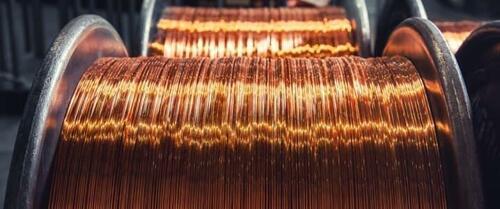Copper's Price Curve Hasn't Looked Like This In Decades
Authored by Tsvetana Paraskova via OilPrice.com,
-
The copper market's extreme contango, not seen since 1994, indicates accumulating inventories and faltering demand, especially from a weakening Chinese property market.
-
Amidst global manufacturing slowdowns and concerns of recessions in developed economies, the copper market hints at an uncertain future, with risks leaning towards a decline in price.
-
Long-term projections, however, remain positive for copper due to the decarbonization drive, with industry experts predicting elevated prices and increased demand as the decade progresses.
The copper market is in a state of extreme contango - a state of the futures curve where futures contracts trade at a premium to the spot price and signal weak prompt demand.
The cash to three-month contango on the London Metals Exchange (LME) jumped at the end of September to the highest since at least 1994 in data compiled by Bloomberg, as inventories pile up while demand seems to falter.
Analysts say that increasing inventories signal weakening demand amid slowing global manufacturing and a weak Chinese property market, and are potentially anticipating recessions in developed economies.
Due to the energy transition push, industry executives and analysts still expect high demand for copper in the medium and long term. But near-term demand and prices could continue to be weak amid an uncertain outlook for the global economy and copper market in China, the world's top commodity consumer.
The faltering Chinese economic rebound after the reopening and the continued weakness in China's property sector have weighed on copper prices this year.
Without a meaningful recovery and amid weaker economies elsewhere, copper prices could further slide in the coming months.
Last month, copper inventories in LME-registered warehouses hit their highest level since May 2022, Ewa Manthey, commodities strategist at ING, wrote in a recent note. Copper stocks held on LME have more than doubled in just two months, which "shows clear signals of weakening demand," Manthey said.
In the first three weeks of September, copper inventories rose by more than 50%, following a similar rise in August.
Futures spreads are loosening, indicating ample supply, ING's Manthey said.
"With rising LME inventories and loosening nearby spreads, more weakness may lie ahead for copper prices," according to the strategist.
Disappointing recovery and a still struggling property sector in China have combined with the Fed's signal that interest rates will be higher for longer, further weighing on prices amid already weakening demand for copper, Manthey noted.
"For copper, risks remain to the downside heading into the year's end on China's uncertain outlook for the property sector. We believe commodity-intensive stimulus is needed to support short to medium-term demand growth," she added.
Globally, manufacturing slowdown and an annual decline in global trade not seen since the pandemic could be weighing on copper demand in the near term, too.
Global trade dropped in July by 3.2% year-on-year – the steepest annual decline in three years since August 2020, according to World Trade Monitor published by the Netherlands Bureau for Economic Policy Analysis, CPB.
"Global goods trade fell at its fastest pace since the pandemic in July and the timelier trade and survey data point to further declines in August and September," Ariane Curtis and Lily Millard of Capital Economics wrote in a note last week.
"What's more, given that we still expect several advanced economies to fall into mild recessions in the coming quarters, weak demand for certain goods will probably weigh on world trade for several months yet," they said.
The copper market reflects concerns about a global economic slowdown and still waits to see a sustained recovery in China.
BHP, the world's largest miner by market capitalization, said in August that volatile copper prices so far this year were the result of "two-way fluctuations based on expectations of China's recovery, and mounting demand risks in the OECD, with indicators of manufacturing weakness widespread."
Still, the long-term prospects for copper are promising as the decarbonization drive will boost demand, said BHP, adding, "We anticipate that the industry is likely to enter the final third of this decade with a low inventory buffer, and therefore elevated prices may endure throughout this period."
Robert Friedland, the billionaire mining investor and founder of Canadian mining company Ivanhoe Mines, is unconcerned with the current weakness in the copper market as medium and long-term demand for the metal is set to soar.
A supply crisis in the copper market is looming, Friedland told Bloomberg TV back in May, adding that there would not be enough new production to meet future demand for one of the key metals for the energy transition.
https://ift.tt/rA96CcL
from ZeroHedge News https://ift.tt/rA96CcL
via IFTTT






0 comments
Post a Comment